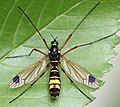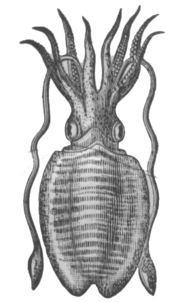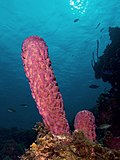Ctenophora (/təˈnɒfərə/ tə-NOF-ər-ə; sg.: ctenophore /ˈtɛnəfɔːr, ˈtiːnə-/ TEN-ə-for, TEE-nə-; from Ancient Greek κτείς (kteis) 'comb' and φέρω (pherō)...
119 KB (12,423 words) - 19:32, 31 December 2024
Ctenophora is a genus of true crane flies. The species are large (about 20 mm long, with 25-mm wingspans), shiny black craneflies with large yellow, orange...
5 KB (270 words) - 16:13, 26 May 2024
Ctenophora festiva is a true crane fly species in the genus Ctenophora. It is found in Europe. "Ctenophora festiva Meigen, 1804". www.gbif.org. Retrieved...
753 bytes (31 words) - 15:46, 26 November 2019
other animal lineages Ctenophora and Porifera is debated. Some phylogenomic studies have presented evidence supporting Ctenophora as the sister to Parahoxozoa...
15 KB (1,414 words) - 20:34, 8 December 2024
Ctenophora ornata is a true crane fly species in the genus Ctenophora. It is found in Europe. Die Fliegen, JW Meigen, 1818 GBIF. "Ctenophora ornata Meigen...
1 KB (34 words) - 22:01, 30 September 2023
kingdom is divided into five infrakingdoms/superphyla, namely Porifera, Ctenophora, Placozoa, Cnidaria and Bilateria. Most living animal species belong to...
118 KB (10,361 words) - 17:20, 26 January 2025
(corals, true jellies, sea anemones, sea pens, and their relatives) and Ctenophora (comb jellies). The name comes from Ancient Greek κοῖλος (koîlos) 'hollow'...
7 KB (684 words) - 12:52, 6 January 2025
Ctenophora apicata is a species of large crane fly in the family Tipulidae. "Ctenophora apicata Report". Integrated Taxonomic Information System. Retrieved...
1 KB (58 words) - 06:53, 26 September 2019
Megachile ctenophora is a species of bee in the family Megachilidae. It was described by Holmberg in 1886. "Megachile". BioLib. 2014. Retrieved 10 October...
622 bytes (28 words) - 03:35, 23 June 2018
Ctenophora nubecula is a species of large crane fly in the family Tipulidae. "Ctenophora nubecula Report". Integrated Taxonomic Information System. Retrieved...
1 KB (58 words) - 06:54, 26 September 2019
Somatina ctenophora is a moth of the family Geometridae. It is found in Kenya, Namibia and South Africa. Wikimedia Commons has media related to Somatina...
1 KB (72 words) - 18:30, 31 December 2020
clade consisting of the Porifera and ParaHoxozoa as a sister group of Ctenophora. An alternative phylogeny is given by the Porifera-sister hypothesis in...
5 KB (111 words) - 20:22, 2 December 2024
historical context. In the early 19th century, Georges Cuvier united Ctenophora and Cnidaria in the Radiata (Zoophytes). Thomas Cavalier-Smith, in 1983...
7 KB (591 words) - 23:49, 25 October 2023
because the large differences between Porifera (sponges), Cnidaria plus Ctenophora (comb jellies), Placozoa and Bilateria (all the more complex animals)...
86 KB (9,287 words) - 15:43, 28 January 2025
Commons has media related to Ctenophora elegans. Wikispecies has information related to Ctenophora (Ctenophora). Ctenophora elegans at insectoid.info v t e...
1 KB (40 words) - 16:32, 30 January 2024
Collocyte (section Collocytes in Ctenophora)
and celebrated examples of collocytes are those of the Ctenophora (comb jellies). The Ctenophora use their colloblasts or collocytes in hunting and gathering...
8 KB (1,083 words) - 14:27, 29 June 2023
sister group of Porifera (sponges). The basal eumetazoan clades are the Ctenophora and the ParaHoxozoa. Placozoa is now also seen as a eumetazoan in the...
12 KB (1,211 words) - 03:58, 24 November 2024
"Diversity of macrociliary size, tooth patterns, and distribution in Beroe (Ctenophora)". Zoomorphology. 113 (2): 79–89. doi:10.1007/BF00403086. ISSN 0720-213X...
5 KB (449 words) - 02:16, 26 October 2023
(sponges), Cnidaria (jellyfish, hydrozoans, sea anemones and corals), Ctenophora (comb jellies) and Placozoa (tiny blob-like animals). For the most part...
29 KB (2,619 words) - 20:43, 17 January 2025
organisms which develop from such a blastula, and include Cnidaria and Ctenophora, formerly grouped together in the phylum Coelenterata, but later understanding...
2 KB (192 words) - 15:29, 23 February 2024
Cyclocoela is a now-invalid classification of Ctenophora. "www.ncbi.nlm.nih.gov". v t e...
487 bytes (16 words) - 22:17, 22 December 2024
example, in the Cnidaria tentilla usually bear cnidocytes, whereas in the Ctenophora they usually have collocytes. Siphonophores are an example of Cnidaria...
12 KB (1,241 words) - 15:24, 16 November 2024
Ctenophora Genus Class Locality of Origin Notes Images Siphusauctum Stem-group Ctenophora Tulip Beds A stem-group ctenophore colloquially known as the...
80 KB (1,572 words) - 23:37, 23 January 2025
dunlapae is a marine species of ctenophore. It is the first species of ctenophora reported to have giant axons controlling the comb rows. They control the...
1 KB (98 words) - 01:08, 24 July 2023
symmetry are associated with nerve nets, and are found in members of the Ctenophora, Cnidaria, and Echinodermata phyla, all of which are found in marine environments...
21 KB (2,608 words) - 23:12, 2 January 2025
the following cladogram: Animals: Porifera, Diploblasts Diploblasts: Ctenophora, ParaHoxozoa ParaHoxozoa: Placozoa, Cnidaria, Bilateria/Triploblast Bilateria:...
8 KB (670 words) - 20:59, 8 December 2024
e. the bilaterians. The less-advanced taxa (i.e. Placozoa, Porifera, Ctenophora and Cnidaria) do not show unification of their tissues into organs. More...
21 KB (2,102 words) - 14:13, 23 January 2025
are not so primitive, but may instead be secondarily simplified. The Ctenophora and the Cnidaria, which includes sea anemones, corals, and jellyfish,...
45 KB (4,980 words) - 20:06, 20 January 2025
the most basal animal phylum, there is now considerable evidence that Ctenophora may hold that title instead. Additionally, the monophyly of the phylum...
133 KB (13,513 words) - 03:37, 24 January 2025
"Topology-dependent asymmetry in systematic errors affects phylogenetic placement of Ctenophora and Xenacoelomorpha". Science Advances. 6 (10): eabc5162. doi:10.1126/sciadv...
6 KB (423 words) - 09:27, 31 October 2024





















